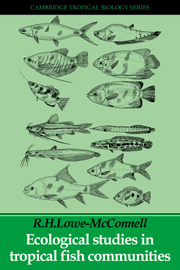8 - Underwater observations: coral reef fishes
Published online by Cambridge University Press: 07 May 2010
Summary
Coral reef environments
Coral reefs harbour the most colourful and diverse of any fish communities, with the most complex relationships between species. The clear shallow warm waters provide natural aquaria, ideal conditions for direct observations of fish behaviour. The most important families of reef fishes are indicated in Table 8.1. Some species are not obligate reef fishes, but have a much wider distribution in association with hard substrates, and some reef fishes are particularly associated with marginal habitats, such as sand patches, lagoons, mangroves, or eel–grass beds (studied by Weinstein & Heck, 1979).
Coral reefs are of three main types: (1) barrier reefs along continents, most extensive along their eastern coasts; (2) fringing reefs, around islands; and (3) atolls, broken rings of reefs and islands around a central lagoon. The Indo–Pacific is particularly rich in corals and reefs, especially in the Indo–Australian archipelago, Malaysia, Sri Lanka, Madagascar, and around Indian Ocean and western Pacific islands. The Australian Great Barrier Reef is an intermittent series of reefs and cays stretching over 1900 km along the coast of Queensland north to New Guinea. Other major coastal reefs lie off the coast of East Africa and in the Red Sea. In the western Atlantic, reefs and cays extend 200 km southward from Yucatan in Central America, and many Caribbean islands are fringed with coral reefs.
- Type
- Chapter
- Information
- Ecological Studies in Tropical Fish Communities , pp. 177 - 211Publisher: Cambridge University PressPrint publication year: 1987



